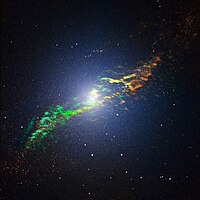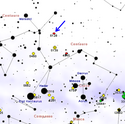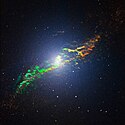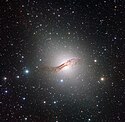Centaurus A
| Centaurus A | |
|---|---|
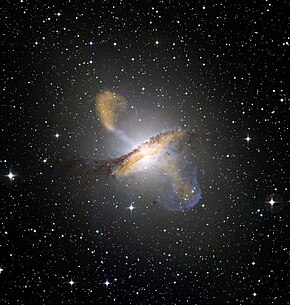 | |
| Pozorovací údaje (Ekvinokcium J2000,0) | |
| Typ | čočková galaxie S0 pec[1] |
| Objevitel | James Dunlop[2] |
| Datum objevu | 1826[2] |
| Rektascenze | 13h 25m 27,6s[1] |
| Deklinace | -43°01′09″[1] |
| Souhvězdí | Kentaur |
| Zdánlivá magnituda (V) | 6,8[2] |
| Úhlová velikost | 25,7' x 20,0'[1] |
| Vzdálenost | 12,4 ± 2,8 Mly (3,79 ± 0,87 Mpc)[1] |
| Plošná jasnost | 13,5[2] |
| Rudý posuv | 0,001 825[1] |
| Fyzikální charakteristiky | |
| Absolutní magnituda (V) | -21,44[1] |
| Označení v katalozích | |
| New General Catalogue | NGC 5128 |
| IRAS | IRAS 13225-4245 a IRAS F13225-4245 |
| Principal Galaxies Catalogue | PGC 46957 |
| Atlas of Peculiar Galaxies | APG 153 |
| Jiná označení | NGC 5128, PGC 46957, Arp 153,[1] Caldwell 77 |
| (V) – měření provedena ve viditelném světle | |
| Některá data mohou pocházet z datové položky. | |
Centaurus A (také známá jako NGC 5128 nebo Caldwell 77) je významná čočková galaxie v souhvězdí Kentaura. Objevil ji skotský astronom James Dunlop v roce 1826 při svém pobytu v Parramatta v Novém Jižním Walesu v Austrálii. Ohledně základních vlastností této galaxie se vedou značné spory; její klasifikace se udává buď jako čočková galaxie, nebo obří eliptická galaxie,[3] vzdálenost se udává v rozsahu 10 až 16 milionů světelných let.[1][4][5][6][7] U galaxie Centaurus A, podobně jako u dalších hvězdotvorných galaxií, panuje podezření, že prudkou tvorbu hvězd spustila galaktická srážka. Modely naznačují, že Centaurus A byla velkou eliptickou galaxií, která se srazila s menší spirální galaxií.[8]
Černá díra
Centaurus A je jednou z nejbližších rádiových galaxií, proto bylo její aktivní galaktické jádro rozsáhle zkoumáno profesionálními astronomy.[9] Ve středu galaxie se nachází obří černá díra s hmotností 55 milionů hmotností Slunce,[10] z níž proudí výtrysky plazmatu, které jsou zdrojem rentgenového záření a rádiových vln. Za deset let rádiového pozorování těchto výtrysků astronomové zjistili, že se jejich vnitřní části pohybují přibližně polovinou rychlosti světla. Rentgenové záření vzniká dále od černé díry, kde se výtrysky sráží s okolními plyny za vzniku velmi energických částic. Rentgenové výtrysky galaxie Centaurus A jsou dlouhé tisíce světelných let, zatímco v rádiovém spektru dosahují délky přes milion světelných let.[11] 
Skladba galaxie
Centaurus A má zvláštní členitost. Při pohledu ze Země vypadá jako čočkovitá nebo eliptická galaxie překrytá prachovým pásem.[12] Zvláštnost této galaxie jako první rozpoznal John Herschel v roce 1847 a Halton Arp ji později zahrnul do svého katalogu zvláštních galaxií (Atlas of Peculiar Galaxies) jako jeden z nejlepších příkladů narušených galaxií zastíněných prachem.[13] Zvláštní tvar této galaxie je obvykle vysvětlován jako důsledek události spojení dvou menších galaxií.[14]
Galaktická výduť je složená hlavně z vyvinutých červených hvězd,[12] ale prachový disk je místem nedávného vzniku hvězd;[9] bylo v něm nalezeno více než 100 hvězdotvorných oblastí.[15]
Supernovy
V galaxii Centaurus A zatím byly pozorovány dvě supernovy. První supernovu označenou SN 1986G s magnitudou 12,5 objevil v oblasti prachového pásu galaxie Robert Evans v roce 1986.[16] Později byla označena za supernovu typu Ia[17] a bylo pomocí ní ukázáno, že spektrum těchto supernov nemusí být vždy stejné a mohou se také lišit ve způsobu, jak se mění jejich jasnost v čase.[17]
Druhá supernova, pojmenovaná SN 2016adj,[18] byla objevena pomocí projektu Backyard Observatory Supernova Search v únoru 2016.[19]
Vzdálenost
Odhady vzdálenosti této galaxie, pořízené od 80. let 20. století, se pohybují mezi 3 a 5 Mpc.[1][4][5][6][7][20] Pomocí klasických delta cefeid objevených ve velmi zastíněném prachovém pásu byla vypočtena vzdálenost přibližně 3 až 3,5 Mpc, podle použitého součinitele zastínění a dalších okolností.[5][6] V galaxii byly kromě mirid[20] objeveny i cefeidy typu II[5][6], které se mimo Místní skupinu galaxií objevují pouze zřídka.[21] Vzdálenost galaxie určená z několika ukazatelů, jako jsou miridy a planetární mlhoviny, se blíží vyšší hodnotě 3,8 Mpc.[3][7]
Pozorování
Galaxie je pátou nejjasnější na obloze,[9] má velkou plošnou jasnost a velký úhlový rozměr, a proto je oblíbeným objektem pozorování amatérských astronomů,[22] i když je pozorovatelná pouze z malých severních šířek a z jižní polokoule. Ve střední Evropě vůbec nevychází nad obzor. Jasná galaktická výduť a tmavý prahový pás mohou být vidět i v hledáčku dalekohledu a velkém triedru. Velký astronomický dalekohled může ukázat i další podrobnosti.[22] Za výjimečně dobrých podmínek může být tato galaxie viditelná pouhým okem.[23] Na obloze se nachází ve střední části souhvězdí Kentaura, 4,5 stupně severně od výrazné, pouhým okem viditelné, kulové hvězdokupy Omega Centauri.
Sousední galaxie
Centaurus A je spolu s galaxií Galaxií Jižní větrník (M83) hlavním členem skupiny galaxií Centaurus A/M83.[24][25][26] Tato skupina někdy bývá dělena na dvě samostatné podskupiny,[27] ale galaxie kolem Centaurus A a M83 jsou fyzicky navzájem velmi blízko a obě podskupiny nevykazují vzájemný pohyb.[28]
Skupina galaxií patří do Místní nadkupy galaxií. Kupa galaxií v Kentaurovi (Abell 3526), která se nachází 6 stupňů západně od galaxie Centaurus A, leží v desetkrát větší vzdálenosti.
Galerie obrázků
- (c) ESA/Hubble, CC BY 4.0
Širokoúhlý snímek galaxie Centaurus A z Hubbleova vesmírného dalekohledu.
Rádiová galaxie Centaurus A na snímku z teleskopu ALMA.
Snímek pořízený širokoúhlou kamerou dalekohledu o průměru 2,2 m na observatoři La Silla (ESO).
Infračervený snímek středové části galaxie Centaurus A s rovnoběžníkem, který vznikl pohlcením menší galaxie před 200 až 700 miliony let (3,58 m NTT, observatoř La Silla).
Silně zastíněný vnitřní spirální disk (s příčkou?) na vlnové délce 24 μm. Spitzerův vesmírný dalekohled.
Rentgenový snímek z dalekohledu Chandra ukazuje výtrysk plazmatu z centrální černé díry.
Snímek galaxie Centaurus A ve viditelném spektru. Very Large Telescope, observatoř Paranal v Chile.
Galaxie Centaurus A na snímku v nepravých barvách: rádiové vlny (červená), infračervené záření 24 μm (zelená) a rentgenové záření 0.5–5 keV (modrá).
Video o výtryscích v galaxii Centaurus A.
Eliptická galaxie Centaurus A a její podivné kulové hvězdokupy.[30]
Reference
V tomto článku byl použit překlad textu z článku Centaurus A na anglické Wikipedii.
- ↑ a b c d e f g h i j NASA/IPAC Extragalactic Database: Results for NGC 300 [online]. [cit. 2016-04-28]. Dostupné online. (anglicky)
- ↑ a b c d The NGC/IC Project: Results for NGC 5128 [online]. [cit. 2016-04-28]. Dostupné v archivu pořízeném dne 2009-05-28. (anglicky)
- ↑ a b Harris, Gretchen L. H. NGC 5128: The Giant Beneath. S. 475. Publications of the Astronomical Society of Australia [online]. Říjen 2010 [cit. 2016-04-29]. Roč. 27, čís. 4, s. 475. Dostupné online. arXiv 1004.4907. DOI 10.1071/AS09063. Bibcode 2010PASA...27..475H. (anglicky)
- ↑ a b J. L. Tonry; A. Dressler; J. P. Blakeslee, et al. The SBF Survey of Galaxy Distances. IV. SBF Magnitudes, Colors, and Distances. S. 681–693. Astrophysical Journal [online]. Leden 2001 [cit. 2016-04-28]. Roč. 546, čís. 2, s. 681–693. Dostupné online. arXiv astro-ph/0011223. DOI 10.1086/318301. Bibcode 2001ApJ...546..681T. (anglicky)
- ↑ a b c d Ferrarese Laura; Mould Jeremy R.; Stetson Peter B., et al. The Discovery of Cepheids and a Distance to NGC 5128. Astrophysical Journal [online]. Leden 2007 [cit. 2016-04-28]. Dostupné online. arXiv astro-ph/0605707. DOI 10.1086/506612. Bibcode 2007ApJ...654..186F. (anglicky)
- ↑ a b c d Majaess, D. The Cepheids of Centaurus A (NGC 5128) and Implications for H0. S. 121. Acta Astronomica [online]. Červen 2010 [cit. 2016-04-28]. Roč. 60, s. 121. Dostupné online. arXiv 1006.2458. Bibcode 2010AcA....60..121M. (anglicky)
- ↑ a b c HARRIS, Gretchen L. H.; REJKUBA, Marina; HARRIS, William E. The Distance to NGC 5128 (Centaurus A). S. 457–462. Publications of the Astronomical Society of Australia [online]. Říjen 2010 [cit. 2016-04-28]. Roč. 27, čís. 4, s. 457–462. Dostupné online. arXiv 0911.3180. DOI 10.1071/AS09061. Bibcode 2010PASA...27..457H. (anglicky)
- ↑ QUILLEN, A. C.; BROOKES, M. H.; KEENE, J., et al. Spitzer Observations of the Dusty Warped Disk of Centaurus A. S. 1092. Astrophysical Journal [online]. Červenec 2006 [cit. 2016-04-29]. Roč. 645, čís. 2, s. 1092. Dostupné online. arXiv astro-ph/0601135. DOI 10.1086/504418. Bibcode 2006ApJ...645.1092Q. (anglicky)
- ↑ a b c F. P. Israel. Centaurus A – NGC 5128. S. 237–278. Astronomy and Astrophysics Review [online]. 1998 [cit. 2016-04-29]. Roč. 8, čís. 4, s. 237–278. Dostupné online. arXiv astro-ph/9811051. DOI 10.1007/s001590050011. Bibcode 1998A&ARv...8..237I. (anglicky)
- ↑ Radio Telescopes Capture Best-Ever Snapshot of Black Hole Jets [online]. NASA [cit. 2016-04-29]. Dostupné online. (anglicky)
- ↑ Astronomy Picture of the Day – Centaurus Radio Jets Rising [online]. NASA, 2011-04-13 [cit. 2016-04-29]. Dostupné online. (anglicky)
- ↑ a b A. Sandage; J. Bedke. Carnegie Atlas of Galaxies. Washington, D.C.: Carnegie Institution of Washington, 1994. ISBN 0-87279-667-1.
- ↑ H. Arp. Atlas of Peculiar Galaxies. S. 1–20. Astrophysical Journal Supplement [online]. Listopad 1966 [cit. 2016-04-29]. Roč. 14, s. 1–20. Dostupné online. DOI 10.1086/190147. Bibcode 1966ApJS...14....1A. (anglicky)
- ↑ W. Baade; R. Minkowski. On the Identification of Radio Sources. S. 215–231. Astrophysical Journal [online]. Leden 1954 [cit. 2016-04-29]. Roč. 119, s. 215–231. Dostupné online. DOI 10.1086/145813. Bibcode 1954ApJ...119..215B. (anglicky)
- ↑ P. W. Hodge; R. C. Kennicutt Jr. An atlas of H II regions in 125 galaxies. S. 296–328. Astrophysical Journal [online]. Březen 1983 [cit. 2016-04-29]. Roč. 88, s. 296–328. Dostupné online. DOI 10.1086/113318. Bibcode 1983AJ.....88..296H. (anglicky)
- ↑ R. Evans; R. H. McNaught; C. Humphries. Supernova 1986G in NGC 5128. S. 1. IAU Circular [online]. Květen 1986 [cit. 2016-04-29]. Roč. 4208, s. 1. Dostupné online. Bibcode 1986IAUC.4208....1E. (anglicky)
- ↑ a b M. M. Phillips; A. C. Phillips; S. R. Heathcote, et al. The type 1a supernova 1986G in NGC 5128 – Optical photometry and spectra. S. 592–605. Publications of the Astronomical Society of the Pacific [online]. Červenec 1987 [cit. 2016-04-29]. Roč. 99, s. 592–605. Dostupné online. DOI 10.1086/132020. Bibcode 1987PASP...99..592P. (anglicky)
- ↑ Gianluca Masi. Supernova SN 2016adj in the peculiar galaxy NGC 5128 (Centaurus A) – 9 Feb. 2016 [online]. [cit. 2016-04-29]. Dostupné online. (anglicky)
- ↑ Bright PSN in NGC5128 (Centaurus A) Discovered By Backyard Observatory Supernova Search (BOSS) [online]. astronomerstelegram.org [cit. 2016-04-29]. Dostupné online. (anglicky)
- ↑ a b REJKUBA, M. The distance to the giant elliptical galaxy NGC 5128. S. 903. Astronomy and Astrophysics [online]. Leden 2004 [cit. 2016-04-29]. Roč. 413, čís. 3, s. 903. Dostupné online. arXiv astro-ph/0310639. DOI 10.1051/0004-6361:20034031. Bibcode 2004A&A...413..903R. (anglicky)
- ↑ Majaess, D.; Turner, D.; Lane, D. Type II Cepheids as Extragalactic Distance Candles. S. 403. Acta Astronomica [online]. Prosinec 2009 [cit. 2016-04-29]. Roč. 59, s. 403. Dostupné online. arXiv 0909.0181. Bibcode 2009AcA....59..403M. (anglicky)
- ↑ a b D. J. Eicher. The Universe from Your Backyard. Cambridge: Cambridge University Press, 1988. Dostupné online. ISBN 0-521-36299-7.
- ↑ Barbara Wilson; Larry Mitchell. Aintno Catalog [online]. [cit. 2016-04-29]. Dostupné online. (anglicky)
- ↑ I. D. Karachentsev; M. E. Sharina; A. E. Dolphin, et al. New distances to galaxies in the Centaurus A group. S. 21–31. Astronomy and Astrophysics [online]. Duben 2002 [cit. 2016-04-29]. Roč. 385, čís. 1, s. 21–31. Dostupné online. DOI 10.1051/0004-6361:20020042. Bibcode 2002A&A...385...21K. (anglicky)
- ↑ R. B. Tully. Nearby Galaxies Catalog. Cambridge: Cambridge University Press, 1988. ISBN 0-521-35299-1.
- ↑ P. Fouque; E. Gourgoulhon; P. Chamaraux, et al. Groups of galaxies within 80 Mpc. II – The catalogue of groups and group members. Astronomy and Astrophysics Supplement [online]. 1992 [cit. 2016-04-29]. Dostupné online. Bibcode 1992A&AS...93..211F. (anglicky)
- ↑ A. Garcia. General study of group membership. II – Determination of nearby groups. S. 47–90. Astronomy and Astrophysics Supplement [online]. Červenec 1993 [cit. 2016-04-29]. Roč. 100, s. 47–90. Dostupné online. Bibcode 1993A&AS..100...47G. (anglicky)
- ↑ I. D. Karachentsev. The Local Group and Other Neighboring Galaxy Groups. S. 178–188. Astronomical Journal [online]. Leden 2005 [cit. 2016-04-29]. Roč. 129, čís. 1, s. 178–188. Dostupné online. arXiv astro-ph/0410065. DOI 10.1086/426368. Bibcode 2005AJ....129..178K. (anglicky)
- ↑ Firestorm of Star Birth in Galaxy Centaurus A [online]. NASA [cit. 2016-05-01]. Dostupné online. (anglicky)
- ↑ The Dark Side of Star Clusters [online]. [cit. 2016-04-29]. Dostupné online. (anglicky)
Externí odkazy
 Obrázky, zvuky či videa k tématu Centaurus A na Wikimedia Commons
Obrázky, zvuky či videa k tématu Centaurus A na Wikimedia Commons - Simbad – Centaurus A
- NED – Centaurus A
- APOD (2003-07-05) Centaurus A: X-Rays from an Active Galaxy
- APOD (2006-03-04) The Galaxy Within Centaurus A
- APOD (2012-04-04) Centaurus A
- SEDS: NGC 5128 (Centaurus A)
- Snímky galaxie Centaurus A získané pomocí HST
- Snímek okolí galaxie Centaurus A
- universetoday.com: Články o galaxii Centaurus A
- constellation-guide.com: Články o galaxii Centaurus A
Média použitá na této stránce
Autor: Martin Hardcastle, Licence: CC-BY-SA-3.0
Centaurus A in radio, 24-micron infrared and X-ray.
Resembling looming rain clouds on a stormy day, dark lanes of dust crisscross the giant elliptical galaxy Centaurus A.
Hubble's panchromatic vision, stretching from ultraviolet through near-infrared wavelengths, reveals the vibrant glow of young, blue star clusters and a glimpse into regions normally obscured by the dust.
The warped shape of Centaurus A's disk of gas and dust is evidence for a past collision and merger with another galaxy. The resulting shockwaves cause hydrogen gas clouds to compress, triggering a firestorm of new star formation. These are visible in the red patches in this Hubble close-up.
At a distance of just over 11 million light-years, Centaurus A contains the closest active galactic nucleus to Earth. The center is home for a supermassive black hole that ejects jets of high-speed gas into space, but neither the supermassive black hole nor the jets are visible in this image.
This image was taken in July 2010 with Hubble's Wide Field Camera 3.Autor: ESO/Digitized Sky Survey. Acknowledgement: Davide de Martin, Licence: CC BY 4.0
This huge elliptical galaxy NGC 5128 (also known as Centaurus A) is the closest such galaxy to the Earth, at a distance of about 12 million light-years. Observations with ESO’s Very Large Telescope in Chile have discovered a new class of “dark” globular star clusters around this galaxy. These are marked in red. Normal globulars are marked in blue and globulars showing similar properties to dwarf galaxies are in green. The dark globulars appear very similar to other globulars around this galaxy but contain much more mass.
(c) ESA/Hubble, CC BY 4.0
This image shows the stunning elliptical galaxy Centaurus A. Recently, astronomers have used the NASA/ESA Hubble Space Telescope to probe the outskirts of this galaxy to learn more about its dim halo of stars.
The galaxy’s halo of stars has been found to reach much further than expected, extending across 4 degrees in the sky — equivalent to eight times the apparent width of the Moon, or almost twice the width of this image.
This image is a composite of images from Digitized Sky Survey 2 (DSS2), the MPG/ESO 2.2-metre telescope, and the NASA/ESA Hubble Space Telescope’s Advanced Camera for Surveys (ACS).
The areas probed by Hubble are identified in the annotated version of this image. Hubble’s unique capabilities allowed astronomers to analyse the faint stars in the halo.Autor: ESO, Licence: CC BY 4.0
This image of Centaurus A, also known as NGC 5128, is an example of how frontier science can be combined with aesthetic aspects. This galaxy is a most interesting object and is being investigated by means of observations in all spectral regions, from radio via infrared and optical wavelengths to X- and gamma-rays. It is one of the most extensively studied objects in the southern sky.
Autor: ESO/Y. Beletsky, Licence: CC BY 3.0
This image of the central parts of Centaurus A reveals the parallelogram-shaped remains of a smaller galaxy that was gulped down about 200 to 700 million years ago. The image is based on data collected with the SOFI instrument on ESO’s New Technology Telescope at La Silla. The original image, obtained by observing in the near-infrared through three different filters (J, H and K) was specially processed to look through the dust, providing a clear view of the centre. The field of view is about 4 x 4 arcminutes.
- A Hubble Space Telescope (HST) image of the dust disk in front of the nucleus of Centaurus A. Credit: HST/NASA/ESA.
- ESA/Hubble images of Centaurus A
Autor: ESO/WFI (Optical); MPIfR/ESO/APEX/A.Weiss et al. (Submillimetre); NASA/CXC/CfA/R.Kraft et al. (X-ray), Licence: CC BY 4.0
Colour composite image of Centaurus A, revealing the lobes and jets emanating from the active galaxy’s central black hole. This is a composite of images obtained with three instruments, operating at very different wavelengths. The 870-micron submillimetre data, from LABOCA on APEX, are shown in orange. X-ray data from the Chandra X-ray Observatory are shown in blue. Visible light data from the Wide Field Imager (WFI) on the MPG/ESO 2.2 m telescope located at La Silla, Chile, show the background stars and the galaxy’s characteristic dust lane in close to "true colour".
Video about Centaurus A jets.
Autor: MoreInput, Licence: CC BY-SA 4.0
Schematic diagram of the components of the Centaurus A galaxy
Autor: ALMA (ESO/NAOJ/NRAO); ESO/Y. Beletsky, Licence: CC BY 3.0
This new image of Centaurus A combines ALMA and near-infrared observations of the massive elliptical radio galaxy. The new ALMA observations, shown in a range of green, yellow and orange colours, reveal the position and motion of the clouds of gas in the galaxy. They are the sharpest and most sensitive such observations ever made.
ALMA was tuned to detect signals with a wavelength around 1.3 millimetres, emitted by molecules of carbon monoxide gas. The motion of the gas in the galaxy causes slight changes to this wavelength, due to the Doppler effect. The motion is shown in this image as changes in colour. Greener features trace gas coming towards us while more orange features depict gas moving away. We can see that the gas to the left of the centre is moving towards us, while the gas to the right of the centre is moving away from us, indicating that the gas is orbiting around the galaxy.
The ALMA observations are overlaid on a near-infrared image of Centaurus A obtained with the SOFI instrument attached to the ESO New Technology Telescope (NTT).Autor: MoreInput, Licence: CC BY-SA 4.0
Overview over the radio structure of Centaurus A.# First picture shows the overall radio emission of Centaurus A, extending over 2 million light years (assuming distance of 3.8 Mpc)
Autor: MoreInput, Licence: CC BY-SA 4.0
Central part of the galaxy Centaurus A
False-colour X-ray image of the giant elliptical active galaxy Centaurus A (NGC 5128) taken with the orbiting Chandra X-ray Observatory, featuring its 30,000 light-years long jet.
Autor: ESO, Licence: CC BY 4.0
The peculiar galaxy Centaurus A (NGC 5128) is pictured in this image taken with by the Wide Field Imager attached to the MPG/ESO 2.2-metre telescope at the La Silla Observatory in Chile. With a total exposure time of more than 50 hours this is probably the deepest view of this peculiar and spectacular object ever created.



